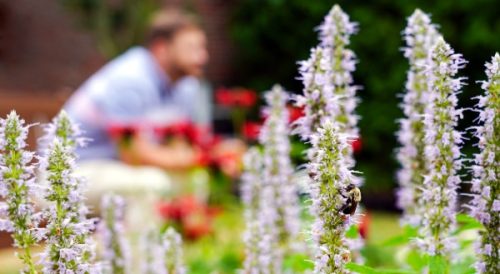Well-being gardens for people, pollinators, and resilient places.
Tell the Bees is my current primary focus. It brings an old New England custom—quietly sharing news with the bees—into contemporary practice as designed gardens for restoration and ecological repair. The work blends landscape, folklore, and evidence-based horticultural care to create spaces that help people steady themselves while strengthening habitat for native pollinators.

What it is
A design framework for healing in living systems. Each garden is an invitation to arrive, release, and restore—simple rituals supported by native plant communities, seasonal bloom succession, and materials that welcome touch and attention. The result is a grounded place to breathe and begin again.
Why it matters
- For people: Clear routines, calming focal points, and gentle sensory cues support recovery, grief work, and everyday steadiness.
- For pollinators: Regionally native plantings, nesting opportunities, and chemical-free care rebuild food webs and local biodiversity.
- For place: Underused ground becomes supportive infrastructure—spaces that do more with what’s already there.
How it works
- Site-specific design: Sun, soil, water, and access drive the plan. Paths and seating create comfort and dignity.
- Native plant palette: Nectar and pollen from early spring through late fall; structure in winter; minimal maintenance.
- Care made simple: Clear signage and seasonal tasks build pride and shared ownership among staff, residents, and visitors.
- Programs and practice: Short on-site practices and printed prompts help people use the garden with confidence and ease.
Where it lives
Tell the Bees Gardens serve recovery centers, senior living communities, cemeteries and natural burial grounds, healthcare and community campuses, and small civic sites. A recent installation at the Charles River Recovery campus on the Waltham–Weston line demonstrates the model: patients helped plant, now help steward, and the garden returns the favor with daily steadiness.
Offerings
- Recovery & Health: Courtyard and campus gardens that integrate with clinical schedules and peer-support routines.
- Senior Living: Therapeutic plantings for memory care and assisted living—safe paths, seated reach, seasonal interest.
- Cemeteries & Natural Burial: Quiet pollinator sanctuaries and shared ritual spaces that honor continuity and care.
- Community & Workplace: Compact gardens and pocket habitats for campuses and public edges.
- Personal Kits: Miniature desktop “Tell the Bees” gardens for individuals and staff—portable practice, daily use.
What you can expect
- A resilient planting plan tailored to your site and region.
- Clear implementation pathway—phasing, budgets, and maintenance that match your capacity.
- Onboarding for staff and community stakeholders so the garden is used, not just admired.
- Measurable ecological uplift: more flowers, more insects, more life over time.
Work with me
If you steward a place where people come to heal, reflect, or gather, Tell the Bees can help that place work harder for them—and for the pollinators that sustain us. Let’s walk the site, listen for what it can do, and build a garden that makes recovery tangible for people and habitat real for the land.